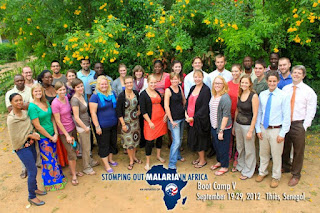The Initiative: Stomping Out Malaria in Africa
The Goal: Near zero deaths from malaria by 2015
The Strategy: Provide intensive training to Peace Corps volunteers across Africa who will in turn provide leadership in the fight against malaria for the 3000 volunteers working on the ground across the continent.
This continent-wide initiative actually grew out of my health district in the south-east corner of Senegal when volunteers several years ago that there was no good reason why every person should not have a bed net and started doing mass distributions to try to achieve universal bed net coverage. The distribution was very successful and got a lot of attention. It was eventually scaled up nation-wide, and other countries are following suit. With this history, I was incredibly excited and honored to be selected to represent Senegal at the fifth Malaria Boot Camp. This intense ten day training (they don't call it boot camp for nothing!) was attended by Peace Corps volunteers and staff from all over Africa: Zambia, Namibia, Mozambique, Botswana, Kenya, Uganda, Madagascar, Burkina Faso, Guinea, The Gambia and, of course, Senegal. Many of the participants had extended to do a third year focused on malaria or had completed their service elsewhere before and had been recruited to do malaria work through the Peace Corps Response. This meant that I had a lot of experience and geographic diversity to learn from. It was fascinating to exchange stories--a good reminder of the enormity of Africa and the many differences, from culture, to climate, to malaria.
 |
| Learning audio-editing software for radio shows after a session on the use of mass-communications in the fight against malaria from Malaria No More/Speak Up Africa |
Ian Hennessee, a second year health volunteer, who has become a great neighbor, mentor and friend, asked us to help out with the roll out of his project that focuses on the early detection and treatment of malaria at the village level. The National Malaria Control Program has a program called PECADOM that involves very basic training on how to test for and treat simple malaria in villages with limited access to health care (ie much of Senegal). Ian's project takes it a step further by giving the recipients of this training an action plan to aggressively seek out and treat cases by doing twice-weekly sweeps of the village and working with groups of women to identify and do a rapid diagnostic test on anyone with symptoms of malaria (typically fever/headache/vomiting). This has big implications, because if you start treatment within the first 24 hours, you can't transmit the parasite to mosquitoes who would bite others in the community.
On the first day of the project, we shadowed the health care workers to make sure everything ran smoothly and to make suggestions of improvements. In the five villages (total population 1395) covered by the project, we tested 149 sick people. 88 were positive for malaria and all got treatment at home except for one case (which had a fever high enough to indicate complicated malaria and was referred to the health post for treatment). In one village, 22% of the village population was tested for malaria, with 12% testing positive and getting treatment! That is a lot of people getting the care they need. It was by far one of the best days of my Peace Corps experience thus far. Kids (and adults) who might never get access to the treatment that is technically provided for free by the government were sought out and cared for. Access came to them. (Pat had to cross several raging rivers to get to the village where he helped out!)
 |
| Children under 5 and pregnant women are the most vulnerable to malaria. This little girl had a fever and was tested for malaria and received treatment. |
The in-depth training provided at Malaria Boot Camp left me feeling empowered to take on these challenges and do the hard work that is needed to meet the goal of near zero deaths from malaria by 2015. Let's stomp out malaria in Africa!
 |
| With this team, a failed jumping picture from our day off on the beach in Popenguine can be reinterpreted as a stomping picture. |


No comments:
Post a Comment